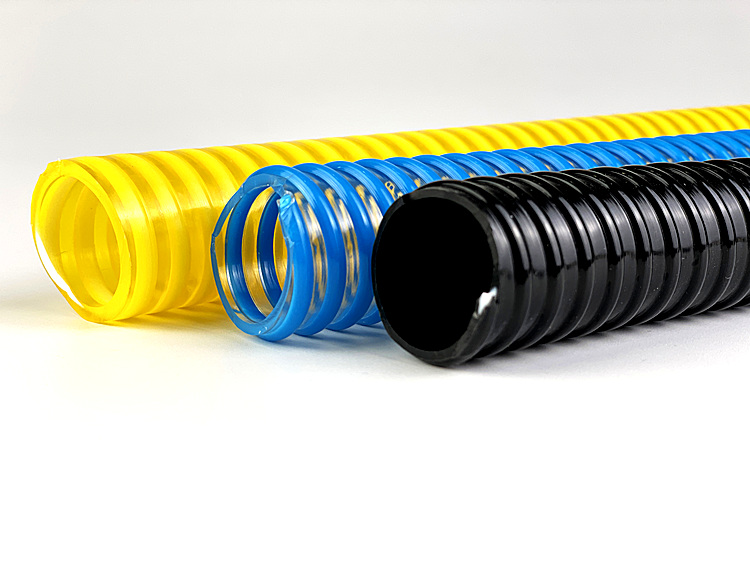The Versatility and Practicality of Spiral Hoses: A Comprehensive Guide
In today’s fast-paced world, industries rely on efficient and reliable machinery to meet their production demands. One crucial component that plays a vital role in various sectors is the spiral hose. In this article, we will delve into the world of spiral hoses, exploring their construction, applications, advantages, and maintenance. So, let’s uncoil the intricacies of spiral hoses step by step.
1. Introduction to Spiral Hoses
Spiral hoses, also known as coiled hoses, are essential components in various industries due to their unmatched versatility and practicality. These hoses are designed to withstand rigorous applications and harsh environments, making them an ideal choice for a wide range of sectors.

spiral suction hose
2. Understanding the Structure
A Closer Look at Materials
Spiral hoses are typically constructed from high-quality materials such as PVC, rubber, or thermoplastic. The choice of material depends on the specific requirements of the application.
Spiral vs. Straight Hose
Unlike traditional straight hoses, spiral hoses feature a unique coiled design that offers greater flexibility without sacrificing strength. This design allows them to handle tight bends and twists with ease.
3. Applications Across Industries
Automotive Sector
In the automotive industry, spiral hoses are widely used for various purposes, including air brake systems, coolant circulation, and hydraulic lines.
Agriculture and Farming
Farmers rely on spiral hoses for irrigation systems, pesticide distribution, and pneumatic tools, thanks to their durability and adaptability.
Construction Sites
Construction sites often employ spiral hoses for concrete pumping, shotcrete, and water supply due to their ability to navigate through tight spaces.
Manufacturing Units
Manufacturing plants utilize spiral hoses for transporting fluids, chemicals, and compressed air, ensuring uninterrupted production processes.
4. The Advantages of Spiral Hoses
Flexibility and Durability
The coiled design of spiral hoses provides exceptional flexibility, allowing them to maintain their shape even under pressure. This flexibility reduces the risk of kinking and extends the hose’s lifespan.
Temperature Resistance
Spiral hoses are designed to withstand extreme temperatures, making them suitable for both hot and cold applications.
Enhanced Flow Rate
The smooth interior of spiral hoses minimizes friction, resulting in an improved flow rate and reduced energy consumption.
5. Proper Installation and Maintenance
Installation Guidelines
Proper installation is essential for maximizing the performance of spiral hoses. Following manufacturer recommendations and guidelines ensures safety and longevity.
Routine Maintenance
Regular inspections and maintenance checks help identify potential issues early, preventing costly downtime.
6. Choosing the Right Spiral Hose
Consideration Factors
When selecting a spiral hose, factors like diameter, length, material, and pressure rating must be considered to meet the specific needs of the application.
Common Sizes and Configurations
Spiral hoses come in various sizes and configurations, making it easier to find the perfect fit for any task.
7. Safety Measures
Preventing Leaks and Drips
Proper installation and maintenance are crucial to prevent leaks and drips, which can lead to safety hazards and environmental concerns.
Avoiding Abrasion
Protecting spiral hoses from abrasion and external damage is essential for their longevity and reliable performance.
8. Environmental Impact
Eco-Friendly Materials
Many spiral hoses are now manufactured using eco-friendly materials, reducing their environmental footprint.
Recycling Options
Recycling programs for old spiral hoses contribute to sustainable practices and waste reduction.
9. Cost-Effectiveness
Long-term Savings
Investing in high-quality spiral hoses may require a larger upfront cost but ultimately leads to long-term savings through reduced maintenance and replacement expenses.
Return on Investment
Spiral hoses often offer an excellent return on investment due to their durability and versatility.
10. Comparing Spiral Hoses to Alternatives
Spiral hoses outperform many alternative hose types in terms of flexibility, durability, and performance across various industries.
11. Future Innovations
Continuous research and development in hose technology are likely to bring forth innovative improvements in spiral hoses.
12. Case Studies
Success Stories
Numerous success stories highlight the significant impact spiral hoses have had on various industries.
Real-World Applications
Discover real-world applications where spiral hoses have revolutionized processes and operations.
13. Conclusion
In conclusion, spiral hoses are indispensable in today’s industrial landscape. Their unique design, versatility, and durability make them an excellent choice for a wide range of applications. As industries continue to evolve, spiral hoses will undoubtedly play a crucial role in enhancing efficiency and productivity.
14. FAQs About Spiral Hoses
1. Are spiral hoses suitable for high-pressure applications?
Yes, spiral hoses are designed to handle high-pressure conditions efficiently.
2. How do I determine the right size of spiral hose for my application?
Consider factors such as flow rate, pressure, and hose length, and consult with a professional if needed.
3. Can spiral hoses be repaired if they get damaged?
Minor damages can often be repaired, but it’s essential to assess the extent of the damage and consult with a specialist.
4. Are spiral hoses environmentally friendly?
Many spiral hoses are made from eco-friendly materials and can be recycled.
5. What industries benefit the most from spiral hoses?
Spiral hoses find applications in a wide range of industries, including automotive, agriculture, construction, and manufacturing.

 sunhose
sunhose sunhose
sunhose